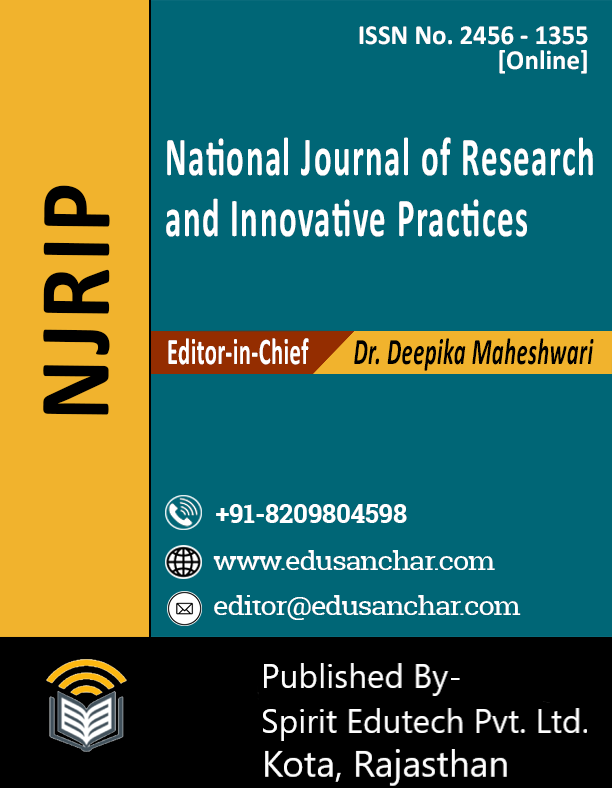
Optimization of Solar Energy Harvesting: An Empirical Approach
Author Name :- Shriyansh singh Rathod,Dr. Kamal Arora,
Journal type:- NJRIP-National Journal of Research and Innovative Practices
Research Field Area :- Engineering and Technology ; Volume 7, Issue 5, No. of Pages: 9
Your Research Paper Id :- 2022010517
Download Published File :- Click here
Abstraction :-
Keywords :-
Optimization, Solar Energy, Renewable energy, Efficiency
References :-
[1] J. Hsieh, Solar Energy Engineering, Prentice-Hall, Englewood Cliffs, NJ, USA, 1986.
[2] B. Sorensen, Renewable Energy, Academic Press, Massachusetts, Mass, USA, 2011.
[3] W. Shepherd and D. W. Shepherd, Energy studies, Imperial College Press, London, UK, 3rd edition, 2014.
[4] R. L. Boylestad and L. Nashelsky, Electronics: A Survey of Electri- cal Engineering Principles, Englewood Cliffs, NJ, USA, 4th edi- tion, 1996.
[5] J. Tester, E. Drake, M. Driscoll, M. Golay, and W. Peters, Sus- tainable energy: Choosing among options, The MIT Press, Cam- bridge, Mass, USA, 2nd edition, 2012.
[6] Solar Energy Industrial Application (SEIA), “U.S. Solar Market Insight”, Retrieved on March 1, 2015 http://www.seia.org/ research-resources/us-solar-market-insight.
[7] EcoWatch Transforming Green, “U.S. Solar Energy Industry Achieves Record-Shattering Year”, Retrieved on March 1, 2015. http://ecowatch.com/2015/03/10/rhone-resch-solar-shattering- year/.Central Electricity Regulatory Commission, Performance of Solar Power Plants in India, New Delhi, India: http://www
.cercind.gov.in, 2011.
[8] Z. Almusaied, B. Asiabanpour, H. Salamy, J. Jimenez, and
S. Aslan, Solar Energy Generation: Roadblocks and Their Economically Viable Remedies, IERC2015, TN, 2015.
[9] J. D. Haan, Solar Panel Information. 2009, Retrieved from: http://www.solarpower2day.net/solar-panels/.
[10] K. Jaiganesh and K. Duraiswamy, “Improving the Power Gen- eration from Solar PV Panel Combined with Solar Thermal System for Indian Climatic Condition,” International Journal of Applied Environmental Sciences, vol. 6, 2013.
[11] L. Dorobantu, M. Popescu, C. Popescu, and A. Craciunescu, “The effect of surface impurities on photovoltaic panels,” Inter- national Conference on Renewable Energy and Power Quality, pp. 622–626, 2011.
[12] C. Honsberg and S. Bowden, Degradation and Failure Modes. Retrieved from: http://pveducation.org/pvcdrom/modules/deg- radation-and-failure-modes, N.D.
[13] D. C. Jordan and S. R. Kurtz, “Photovoltaic Degradation Rates- an Analytical Review,” Progress in Photovoltaics, vol. 21, no. 1, pp. 12–29, 2013.
[14] B. Hammad, A. Al-Sardeah, M. Al-Abed, S. Nijmeh, and A. Al- Ghandoor, “Performance and economic comparison of fixed and tracking photovoltaic systems in Jordan,” Renewable & Sustainable Energy Reviews, vol. 80, pp. 827–839, 2017.
[15] A. Bahrami, C. O. Okoye, and U. Atikol, “Technical and eco- nomic assessment of fixed, single and dual-axis tracking PV panels in low latitude countries,” Journal of Renewable Energy, vol. 113, pp. 563–579, 2017.
[16] H. Su, J. Lin, and F. Tan, “Progress and perspective of biosyn- thetic platform for higher-order biofuels,” Renewable & Sustain- able Energy Reviews, vol. 80, pp. 801–826, 2017.
[17] J. L. Viegas, P. R. Esteves, R. Mel´ıcio, V. M. F. Mendes, and S.
M. Vieira, “Solutions for detection of non-technical losses in the electricity grid: A review,” Renewable & Sustainable Energy Reviews, vol. 80, pp. 1256–1268, 2017.
[18] S. Cross, D. Padfield, R. Ant-Wuorinen, P. King, and S. Syri, “Benchmarking island power systems: Results, challenges, and solutions for long term sustainability,” Renewable & Sustainable Energy Reviews, vol. 80, pp. 1269–1291, 2017.
[19] M. M. Fouad, L. A. Shihata, and E. I. Morgan, “An integrated review of factors influencing the performance of photovoltaic panels,” Renewable & Sustainable Energy Reviews, vol. 80, pp. 1499–1511, 2017.
[20] L. M. Ferna´ndez-Ahumada, F. J. Casares, J. Ram´ırez-Faz, and
R. Lo´pez-Luque, “Mathematical study of the movement of solar tracking systems based on rational models,” Solar Energy, vol. 150, pp. 20–29, 2017.
[21] V. Sumathi, R. Jayapragash, A. Bakshi, and P. Kumar Akella, “Solar tracking methods to maximize PV system output – A review of the methods adopted in recent decade,” Renewable & Sustainable Energy Reviews, vol. 74, pp. 130–138, 2017.
[22] S. W. Quinn, “Energy gleaning for extracting additional energy and improving the efficiency of 2-axis time-position tracking photovoltaic arrays under variably cloudy skies,” Solar Energy, vol. 148, pp. 25–35, 2017.
[23] C. O. Okoye, A. Bahrami, and U. Atikol, “Evaluating the solar resource potential on different tracking surfaces in Nigeria,” Renewable & Sustainable Energy Reviews, 2016.
[24] S. Mantziaris, C. Iliopoulos, I. Theodorakopoulou, and E. Petro- poulou, “Perennial energy crops vs. durum wheat in low input lands: Economic analysis of a Greek case study,” Renewable & Sustainable Energy Reviews, vol. 80, pp. 789–800, 2017.
[25] B. Asiabanpour, Z. Almusaied, S. Aslan et al., “Fixed versus sun tracking solar panels: an economic analysis,” Clean Technologies and Environmental Policy, vol. 19, no. 4, pp. 1195–1203, 2017.
[26] Z. Almusaied, Optimization of Solar Energy Harvesting: Building Infrastructure and Statistical Optimization [M.S. thesis], Texas State University, 2016.
[27] R. H. Myers and D. C. Montgomery, Response Surface Method- ology: Process And Product Optimization Using Designed Exper- iments, J. Wiley, New York, NY, USA, 2002.
[28] D. Montgomery, Design and Analysis of Experiments, John
[29] Wiley & Sons, New York, NY, USA, 1997.


